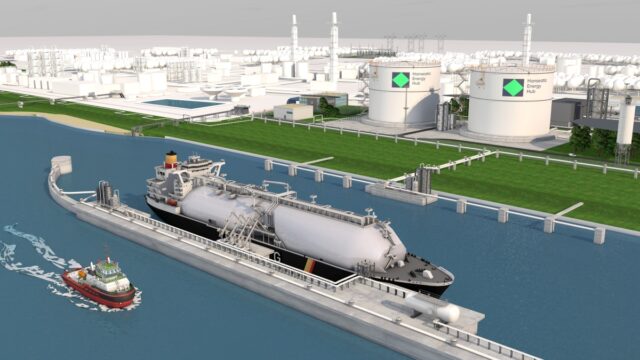Ammonia-ready import terminal gets green light in Stade
By Julian Atchison on April 08, 2024
The Hanseatic Energy Hub reaches FID

Click to learn more. Visualisation of the Hanseatic Energy Hub, an ammonia-ready LNG terminal that will enter operations in 2027. Source: HEH GmbH.
Located in Stade on the Elbe River, the €1 billion Hanseatic Energy Hub will serve as an import terminal for LNG, and subsequently for ammonia. A floating LNG terminal currently operates at the site, with a land-based terminal to be constructed for the expanded import of liquefied gas fuels. A total LNG storage capacity of 13.3 billion m3 will be built, but it’s unclear at this stage what percentage of this will be considered “ammonia-ready”. Técnicas Reunidas will lead construction of the terminal. Project partners Enagás, Dow and the Buss Group announced this month that they have secured finance for the project, which will begin operations in 2027.
The land-based LNG terminal will be a crucial building block in the transition to a net-zero future in Germany and Europe. Thanks to the good local framework conditions and decisive political action, the zero-emission terminal will diversify the energy supply and help secure it in the long term. It offers unique synergy effects between the chemical, logistics and energy industries and acts as an efficient industrial and energy hub around the Stade Industrial Park. It is these bridging technologies that we as an industry in Germany need in order to help shape the transformation in the long term.
Julia Schlenz, Chairwoman of the Executive Board and President Dow Germany in HEH GmbH’s official press release, 21 Mar 2024
The Hub will be situated next door to one of Europe’s largest chemical manufacturing facilities, operated by Dow. Dow Stade is a major producer of chlorine gas via Chloralkali electrolysis: a process that produces hydrogen as a by-product, which Dow currently blends with gas to use as a power generation fuel. Dow currently produces 50,000 tons per year of by-product hydrogen. Dow Stade will also eventually be connected to Europe’s hydrogen backbone, a continent-wide hydrogen pipeline network.
Brunsbüttel, Hamburg, Rostock, Wilhelmshaven and Stade
The project joins a long list of ammonia import terminals planned along Germany’s coastline. Just downriver from the Hanseatic Energy Hub, RWE is developing an import hub in Brunsbüttel, with plans to receive 300,000 tons per year of Namibian ammonia from 2027. Upriver from HEH at the Port of Hamburg, Air Products and Mabanaft are progressing plans for “New Energy Gate”, an ammonia import terminal linked to Pattern Energy’s export production project in Newfoundland, Canada. Further down the German coast in Wilhelmshaven, Uniper is developing a major ammonia import hub. And, on the other side of Jutland in the Baltic Sea, German gas utility VNG and Yara are exploring upgrades and conversions to turn the Port of Rostock into an ammonia import, cracking and distribution hub.